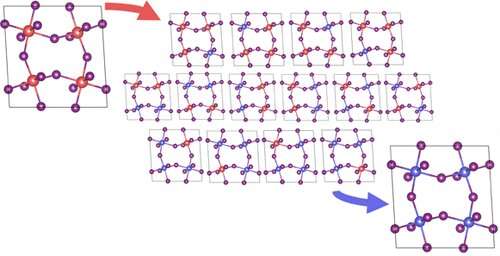Two-dimensional (2D) Ruddlesden–Popper perovskites (RPPs) of the form PEA2Pb1–xSnxI4 can be used as the tunable active layer in photovoltaics, as the passivating layer for 3D perovskite photovoltaics or in light emitting diodes. Here, we show a nonlinear band gap behavior with Sn content in mixed phase 2D RPPs. Density functional theory calculations (with and without spin–orbit coupling) are employed to study the effects of the short-range ordering of Pb and Sn in PEA2Pb1–xSnxI4 compositions with x = 0, 0.25, 0.5, 0.75, and 1. Analysis of the partial density of states shows that the energy mismatch of the Pb 6s and Sn 5s states in the valence band maximum determines the nonlinearity of the band gap, leading to a bowing parameter of 0.35–0.38 eV. This research provides a critical insight for the design of future metal alloy 2D perovskite materials. The positions of the tunable energy band discontinuity may point to intraband transitions of interest to device engineers. Credit: The Journal of Physical Chemistry Letters (2021). DOI: 10.1021/acs.jpclett.0c03699
An innovative analysis of two-dimensional (2D) materials from engineers at the University of Surrey could boost the development of next-generation solar cells and LEDs.
Three-dimensional perovskites have proved themselves remarkably successful materials for LED devices and solar panels in the past decade. One key issue with these materials, however, is their stability, with device performance decreasing quicker than other state-of-the-art materials. The engineering community believes the 2D variant of perovskites could provide answers to these performance issues.
In a study published in the Journal of Physical Chemistry Letters, researchers from Surrey's Advanced Technology Institute (ATI) detail how to improve the physical properties of 2D perovskite called Ruddlesden-Popper.
The study analyzed the effects of combining lead with tin inside the Ruddlesden-Popper structure to reduce the toxic lead quantity. This also allows for the tuning of key properties such as the wavelengths of light that the material can absorb or emit at the device level—improving the performance of photovoltaics and light-emitting diodes.
Cameron Underwood, lead author of the research and postdoctoral researcher at the ATI, said:
"There is rightly much excitement about the potential of 2D perovskites, as they could inspire a sustainability revolution in many industries. We believe our analysis of strengthening the performance of perovskite can play a role in improving the stability of low-cost solar energy and LEDs."
Professor Ravi Silva, corresponding author of the research and Director of the ATI, said:
"As we wean ourselves away from fossil energy sources to more sustainable alternatives, we are starting to see innovative and ground-breaking uses of materials such as perovskites. The Advanced Technology Institute is dedicated to being a strong voice in shaping a greener and more sustainable future in electronics—and our new analysis is part of this continuing discussion."
More information: Cameron C. L. Underwood et al. Nonlinear Band Gap Dependence of Mixed Pb–Sn 2D Ruddlesden–Popper PEA2Pb1–xSnxI4 Perovskites, The Journal of Physical Chemistry Letters (2021). DOI: 10.1021/acs.jpclett.0c03699
Journal information: Journal of Physical Chemistry Letters
Provided by University of Surrey
























